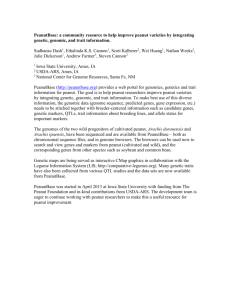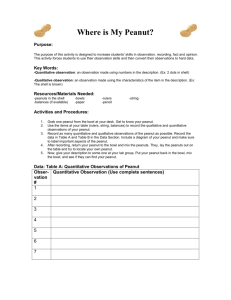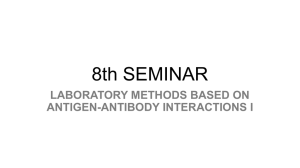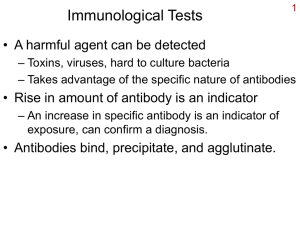peanut
advertisement
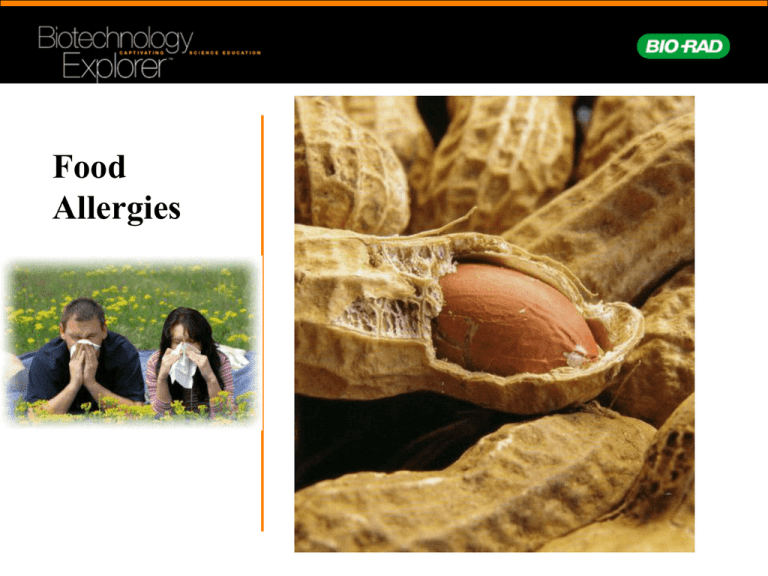
Food Allergies Peanut Allergy Most prevalent food allergy in the US. 1.5 million people suffer from the allergy. Exposure to a small amount of peanut protein can trigger a potentially fatal reaction. How small? A standard peanut has about 200 mg of protein, and studies have shown that some people have an allergic reaction to just 2 mg—or around 1% of one peanut. Peanut allergies do not cause problems with the first exposure to peanuts. The immune system develops antibodies as a first reaction to the peanut protein. The next time the body comes in contact with these proteins, the antibodies attack the peanut proteins. This induces the allergic reaction which can be caused by direct contact, crosscontact and even inhalation. With subsequent exposure, when the IgE antibodies on the mast cells make contact with the allergens, the mast cells release chemicals such as histamine into the bloodstream. The histamine causes such allergic reactions as a runny nose, tearing eyes, sore throat, diarrhea, skin rashes, or difficulty breathing and swelling. A severe reaction is termed anaphylaxis. Loss of consciousness or even death may ensue if not treated. Food Allergen Labeling and Consumer Protection Act (FALCPA) 1/1/06 requires all packaged foods comply with its food allergen labeling requirements. Eight major food allergens (peanut products as well as milk, egg, fish, crustacean shellfish, tree nuts, wheat and soybeans) must be labeled in language that is easy to understand. Products exempt from plain English labeling rules: foods that are not regulated by the FDA, cosmetics and personal care products, prescription and over‐the‐counter medications or supplements, pet food, toys and crafts. *The FDA has exempted peanut oil from being labeled as an allergen. Detecting the peanut protein in food Links to the Real World ELISA Enzyme-Linked Immunosorbant Assay • HIV, Mad Cow, SARS • Biodefense • Cancer treatment • Drug and steroid testing • Pregnancy / Reproduction • GMO ELISA Antibody Structure Heavy chain Disulfide bonds Light chain ELISA Antibody Structure The more antigen the darker the color 1 2 ELISA Kit Workstation Inventory Reagents: Yellow tubes Violet tube (+) Blue tube (-) Green tube (PA) Orange tube (SA) Test samples (#1-#3) Positive control Negative control Primary antibody Secondary antibody Lab Equipment and Supplies: Microplate strips, pipettor, pipette tips, transfer pipette, wash buffer, paper towels, marking pen 3 2 1 1 1 1 ELISA Enzyme-Linked Immunosorbant Assay ELISA Kit Results What Are The Reagents? And What Function Do They Perform? PBS: Phosphate buffered saline – provides stable buffered environment to maintain antibody structure Tween 20: Nonionic detergent – removes nonspecifically bound proteins to reduce background and blocks protein binding sites on the polystyrene Microplates: Polystyrene – proteins absorb (bind) by hydrophobic bonds to the polystyrene What Are The Reagents? And What Function Do They Perform? Antigen: Chicken gamma globulin Primary antibody: Polyclonal anti-chicken antibody made by rabbits Secondary antibody: Polyclonal anti-rabbit antibody made by goats linked (conjugated) to horseradish peroxidase (HRP) Enzyme substrate: 3,3’,5,5’ – tetramethylbenzidine (TMB) – a colorless solution that when oxidized by HRP turns blue Allergic Reaction The reaction is an abnormal immune system response to things that are normally harmless. When one is allergic, the immune system incorrectly identifies the substance as harmful to one's body. (ie. certain foods, medicines, plant pollen, or dust, are called allergens.) To protect the body, on first contact, the immune system produces immunoglobulin E antibodies which become attached to mast cells.
